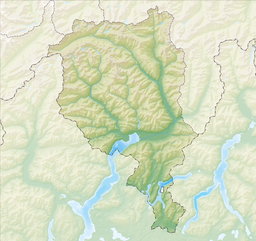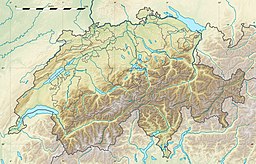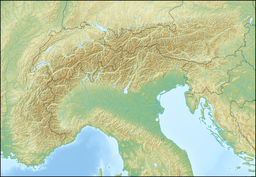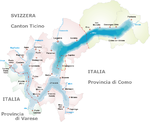Lake Lugano
| Lake Lugano | |
|---|---|
| Lago di Lugano | |
| Lagh de Lugan(Lombard) | |
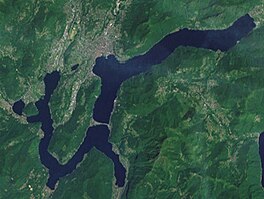 Satellite image of Lake Lugano | |
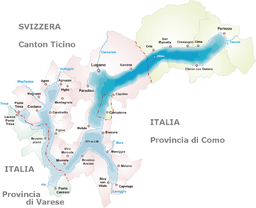 Map of the lake | |
| Location | Ticino,Lombardy |
| Coordinates | 45°59′N8°58′E/ 45.983°N 8.967°E |
| Primary inflows | Vedeggio,Cassarate,Cuccio,Mara,Laveggio,Magliasina,Bolletta,Scairolo |
| Primary outflows | Tresa |
| Catchment area | 565.6 km2(218.4 sq mi) |
| Basincountries | Switzerland, Italy |
| Surface area | 48.7 km2(18.8 sq mi) |
| Average depth | 134 m (440 ft) |
| Max. depth | 288 m (945 ft) |
| Water volume | 6.5 km3(1.6 cu mi) |
| Residence time | 8.2 years |
| Surface elevation | 271 m (889 ft) |
| Sections/sub-basins | North basin, South basin, Ponte Tresa |
| Settlements | Lugano,Melide,Campione d'Italia,Ponte Tresa |
 | |
Lake Lugano(Italian:Lago di LuganoorCeresio,fromLatin:Ceresius lacus;Lombard:Lagh de Lugan) is aglacial lakewhich is situated on the border between southernSwitzerlandand northernItaly.The lake, named after the city ofLugano,is situated betweenLake ComoandLago Maggiore.It was cited for the first time byGregory of Toursin 590 with the nameCeresio,[1]a name which is said to have derived from theLatinwordcerasus,meaningcherry,and refers to the abundance of cherry trees which at one time adorned the shores of the lake.[2]The lake appears in documents in 804 under the nameLaco Luanasco.[1]

There are various mountains and tourist destinations on the shores of the lake includingMonte Brèto the east,Monte San Salvatorewest of Lugano, andMonte Generosoon the south-eastern shore. TheWorld Heritage SiteMonte San Giorgiois situated south of the lake. Also located to the south is theCinque Vette Park.
The lake is drained by theTresa,which empties intoLake Maggiore,the latter being drained by theTicinoand thePo.
History
[edit]The first certain testimony of a political body governing the shores of the lake is from 818. Occupying an area of strategic importance, the lake was then part of thefeudaldominion of the County of Sperio. Circa 1000, it came under the control of theBishop of Como.The region was the site of the war between Como andMilanover control of Alpine traffic from 1218 to 1227. As the lake and its shores became progressively incorporated into theDuchy of Milanthey became the subject of political and territorial contention during the 15th century, and Lugano became the lake's main town.[1]
The lake definitively ceased to belong to a single sovereign political entity following the establishment of the transalpinebailiwicksof the Swiss cantons at the beginning of the 16th century. The Italian-Swiss border was fixed in 1752 by the Treaty of Varese, and has since remained virtually unchanged.[1]
In 1848, theMelide causewaywas built on amorainebetweenMelideandBissone,in order to carry a road across the lake and provide a direct connection between Lugano andChiasso.Today the causeway also carries theGotthard railwayand theA2 motorway.
Geography
[edit]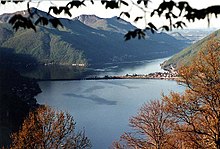

The lake is 48.7 km2(18.8 sq mi) in size, 63% of which is in Switzerland and 37% in Italy. It has an average width of roughly 1 km (0.62 mi) and a maximum width of about 3 km (1.9 mi) at the bay of Lugano. A maximum depth of 288 m (945 ft) is found in the northern basin. The culminating point of the lake's drainage basin is thePizzo di Ginosummit in theLugano Prealps(2,245 m; 7,365 ft).[3]Bathing in the lake is allowed at any of the 50 or so bathing establishments located along the Swiss shores.[4]
The ItalianexclaveofCampione d'Italiaand parts of the waters of the lake are considered by European Customs Law as non-territorial for fiscal purposes and as such enjoy a special tax status as a duty-free area, exemption fromEU VAT[5] and offer residents other advantageous tax privileges.
TheMelide causewayseparates the northern (27.5 km2;10.6 sq mi) and southern (21.4 km2;8.3 sq mi)basins,although a bridge in the causeway permits water flow and navigation. Thelake retention timeis an average of 8.2 years; that of the northern basin (11.9 years) is considerably higher than the southern one (2.3 years).
Places on the lake in Switzerland (CH) and in Italy (I) include (from Lugano, clockwise):
- Lugano(CH)
- Cassarate(CH)
- Castagnola(CH)
- Gandria(CH)
- Oria,Valsolda(I)
- San Mamete(I)
- Cressogno (I)
- Porlezza(I)
- Cantine di Gandria (CH)
- Caprino(CH)
- Campione d'Italia(I)
- Bissone(CH)
- Maroggia(CH)
- Melano(CH)
- Capolago(CH)
- Riva San Vitale(CH)
- Brusino-Arsizio(CH)
- Porto Ceresio(I)
- Brusimpiano(I)
- Lavena Ponte Tresa(I)
- Ponte Tresa(I/CH)
- Caslano(CH)
- Magliaso(CH)
- Agno(CH)
- Agnuzzo(CH)
- Montagnola(CH)
- Carabietta(CH)
- Figino(CH)
- Morcote(CH)
- Melide(CH)
- Paradiso(CH)
Navigation
[edit]
The lake is navigable, and used by a considerable number of private vessels. Passenger boats of theSocietà Navigazione del Lago di Lugano(SNL) provide services on the lake, principally for tourist purposes, but also connecting Lugano with other lakeside communities, some of which have no road access.
Fisheryin the lake (and Lake Maggiore) is regulated by a 1986 agreement between Switzerland and Italy. The current agreement onnavigationdates from 1992.
Pollution
[edit]Pollutionhas long been a problem in Lake Lugano. In the 1960s and 1970s it was officially forbidden to bathe in the lake.[6]Despite the continued introduction ofsewage treatment plants,such as inGandria,factors, such as lake retention time andlack of oxygenand increasingphosphorusconcentrations, means it is unclear if the lake will recover.
TheFederal Office for the Environment's last published report on Lake Lugano dates from 1995.[7]To summarise that report:
- at that time measurements indicated some improvement, but this was unlikely to continue at the same pace
- there were almost permanent polluted layers at the bottom of the very deep lake
- oxygen was scarce and could not be found below 100 m (330 ft) depth
- as a result phosphorus levels were increasing at this depth
- phosphorus levels in the northern basin were six times too high and in the southern basin twice too high
- will take many decades to clean
- the lake could be said to be "chronically sick"
- in the Italian part of the lake only 20% of the population were connected to sewage treatment plants with phosphorus filters (not that all Swiss areas were connected either).
The Swiss-Italian organisation CIPAIS in its most recent published report[8]says:
Considering the results obtained in 2009 it can be affirmed that, notwithstanding the observed improvement, Lake Lugano is still in a state of higheutrophication,the highest among Swiss lakes.
The Italian environmental group Legambiente, in its 2007 study of all northern Italian lakes,[9][10]found Lake Lugano to be the most polluted of all.
All water samples were well beyond the legal limits. The polluted sites should not be bathed in for health reasons. Bacteria can cause in the worst case, skin infections, diarrhoea and vomiting.
According to Legambiente, the only reason swimming was not banned on the Italian Lakes was because thestate of Lombardychanged the law. They state that pollution levels in the lakes do not conform to European rulings and the lack of sewage treatment is illegal.
Their 2010 measurements[11]found samples taken atPonte Tresa,OstenoandPorto Ceresioto be "heavily polluted" (more than 1,000 UFC/100 mlintestinal enterococciand/or greater than 2000 UFC/100 mlE. coli).
Fauna
[edit]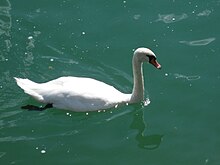
The lake is full of fish. Apart from a few protected areas, such as the mouth of theRiver CuccioinPorlezza,fishing is allowed anywhere, although according to various regulations. Protected species are thebleakand thewhite clawed crayfish(Austropotamobius pallipes). The bleak is almost extinct here, unlike in Lago Maggiore, and planning is under way for the controlled repopulation of the lake, particularly aroundPonte Tresa.
In 1895 thebrook troutwas introduced fromLake Zug,while between 1894 and 1897 thecommon whitefishwas introduced. Since 1950 attempts have been made to introduce the whitefishCoregonus macrophthalmusfromLake Neuchâtel,but it has not established itself effectively.
TheCommon Roachis present in large numbers and took around ten years to colonise the entire lake, thereby replacing the bleak. Still present are theEuropean chub,tench,carpand a few examples ofEuropean perch,largemouth bass,zanderandburbot.Recently thewels catfishandpigohave been spotted.
Fossils
[edit]The whole area behind the southern shores of Lake Lugano is rich in fossils. The focal point of these fossil deposits isMonte San Giorgio,where since the 19th century many fossils have been found dating from the mid-Triassic(around 220 million years ago). The deposits on Monte San Giorgio stretch towards the west into Italian territory and the deposits ofBesano.Fossils dating from the earlyJurassic(around 180 million years ago) have also been found along the southern shores but more towards the east andOsteno.
Panorama
[edit]See also
[edit]References
[edit]- ^abcd"Lake Lugano".Historic Dictionary of Switzerland(in Italian).Retrieved2008-11-23.
- ^"Itinerari - Il Lago dei Ciliegi".Il Gommone(in Italian). Archived fromthe originalon 2006-05-06.Retrieved2008-11-22.
- ^1:25,000 topographic map(Map).Swisstopo.Retrieved2014-07-28.
- ^"Stato di Salute del Ceresio".LakeLugano.ch.Società Navigazione Lago di Lugano. Archived fromthe originalon 2008-12-28.Retrieved2008-11-22.(in Italian)
- ^"European Union Customs Code REGULATION (EU) No 952/2013 OF THE EUROPEAN PARLIAMENT AND OF THE COUNCIL".European Union.Retrieved2016-10-09.See Article 4
- ^"Better quality of life on the lake - the swimming ban in the 70s".Societa Navigazione del Lago di Lugano. 2011.Retrieved31 March2011.
- ^"The condition of the lakes in Switzerland".Swiss Federal Office for the Environment. 2009.Retrieved31 March2011.
- ^Institute of Earth Sciences of the University of Applied Sciences of Southern Switzerland IST-SUPSI (2009)."Ricerche sull'evoluzione del Lago di Lugano"(PDF).CIPAIS.Archived fromthe original(PDF)on 21 July 2011.Retrieved31 March2011.
- ^"Italy's lakes have sick water".Belfast Telegraph.27 July 2007.Retrieved31 March2011.
- ^North Italy lakes are heavily polluted"State of Lake Lugano",Die Welt(translated), 3 August 2007, accessed March 31, 2011.
- ^"Monitoring data on the lakes Maggiore, Lugano, Varese"Legambiente,2010, accessed March 31, 2011.
External links
[edit]- Lake Lugano Navigation Company(in Italian)—Includes timetables
- Legambiente
- CIPAIS Commissione Internazionale per la Protezione delle Acque Italo-Svizzere(in Italian)limnologic reports
- Coolidge, William Augustus Brevoort(1911)..Encyclopædia Britannica.Vol. 17 (11th ed.). p. 115.
- Lake LuganoinGerman,FrenchandItalianin the onlineHistorical Dictionary of Switzerland.
- Convenzione del 2 dicembre 1992 fra la Svizzera e l’Italia per la disciplina della navigazione sul lago Maggiore e sul lago di Lugano (con R e all.)(in Italian, German, and French)agreement on navigation
- Convenzione del 19 marzo 1986 tra la Confederazione Svizzera e la Repubblica Italiana per la pesca nelle acque italo-svizzere(in Italian, German, and French)agreement on shipping
- Waterlevels at Ponte Tresafrom the Federal Office for the Environment
- Waterlevels at Melide, Ferrerafrom the Federal Office for the Environment

